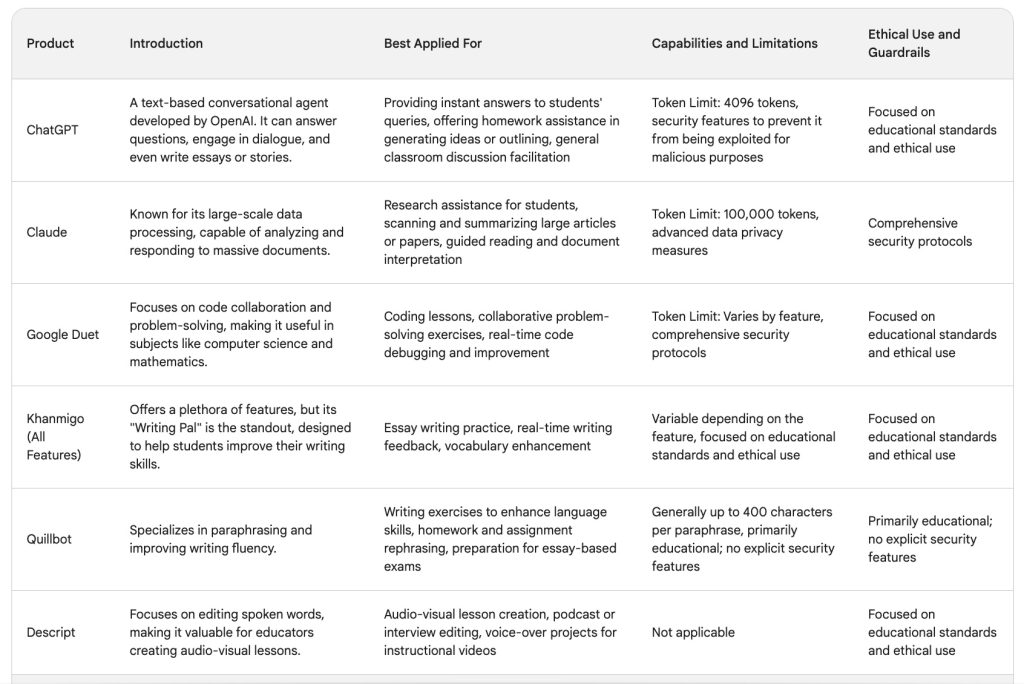Chapter 6: The AI GPT Toolkit – Essential Technologies for Teaching

As a technologist, inventor, and AI enthusiast, I’ve spent years applying AI tools in pragmatic ways to create real solutions. The right tool can drastically improve student engagement, streamline your workload, and offer enriching learning experiences. But not all tools are created equal, and it’s vital to understand their capabilities and limitations. In this chapter, we’ll delve into some leading AI technologies to give you a grounded perspective on where each tool could fit into your teaching toolbox.
First a quick note on “Tokens”. A token is nothing more than a measure of the amount of data the AI is able to hold in its memory as you interact with it. In other words, you care about this because that AI you are interacting with starts to forget things you have asked it or taught it after that much information has been provided. Imagine if your word document just lost the beginning of the document as you scrolled down 15 pages!
A single token in ChatGPT can be as short as one character or as long as one word. The average length of a token in ChatGPT is 4.6 characters. This means that the token limit of 4096 tokens is equivalent to a maximum of 19,024 characters.
However, it is important to note that not all characters are created equal. Some characters, such as punctuation marks, are shorter than others. This means that the actual number of words that can be generated by ChatGPT with a token limit of 4096 is slightly less than 19,024.
In general, it is best to keep the length of your prompts and responses to ChatGPT as short as possible. This will help to ensure that you get the best results.
1. ChatGPT
Introduction:
ChatGPT is a text-based conversational agent developed by OpenAI. It can answer questions, engage in dialogue, and even write essays or stories.
Best Applied For:
- Providing instant answers to students’ queries
- Offering homework assistance in generating ideas or outlining
- General classroom discussion facilitation
Capabilities and Limitations:
- Token Limit: 4096 tokens (each token can be as short as one character or as long as one word)
- Ethical Use and Guardrails: Security features to prevent it from being exploited for malicious purposes
2. Claude
Introduction:
Claude is known for its large-scale data processing, capable of analyzing and responding to massive documents.
Best Applied For:
- Research assistance for students
- Scanning and summarizing large articles or papers
- Guided reading and document interpretation
Capabilities and Limitations:
- Token Limit: 100,000 tokens
- Ethical Use and Guardrails: Advanced data privacy measures
I used Claude.ai for the Hemingway interaction in the appendix.
3. Google Duet
Introduction:
Google Duet focuses on code collaboration and problem-solving, making it useful in subjects like computer science and mathematics.
Best Applied For:
- Coding lessons
- Collaborative problem-solving exercises
- Real-time code debugging and improvement
Capabilities and Limitations:
- Token Limit: Varies by feature
- Ethical Use and Guardrails: Comprehensive security protocols
4. Khanmigo (All Features)
Introduction:
Khanmigo offers a plethora of features, but its “Writing Pal” is the standout, designed to help students improve their writing skills.
Best Applied For:
- Essay writing practice
- Real-time writing feedback
- Vocabulary enhancement
Capabilities and Limitations:
- Token Limit: Variable depending on the feature
- Ethical Use and Guardrails: Focused on educational standards and ethical use
5. Quillbot
Introduction:
Quillbot specializes in paraphrasing and improving writing fluency.
Best Applied For:
- Writing exercises to enhance language skills
- Homework and assignment rephrasing
- Preparation for essay-based exams
Capabilities and Limitations:
- Token Limit: Generally up to 400 characters per paraphrase
- Ethical Use and Guardrails: Primarily educational; no explicit security features
6. Descript
Introduction:
Descript focuses on editing spoken words, making it valuable for educators creating audio-visual lessons.
Best Applied For:
- Audio-visual lesson creation
- Podcast or interview editing
- Voice-over projects for instructional videos
Capabilities and Limitations:
- Token Limit: Not applicable
- Ethical Use and Guardrails: Strong data encryption and privacy measures
By familiarizing yourself with these AI tools, you can make informed decisions on which technologies best suit your educational goals. Always remember to consider not only the capabilities but also the ethical guardrails to ensure you’re providing a safe and enriching environment for your students.

